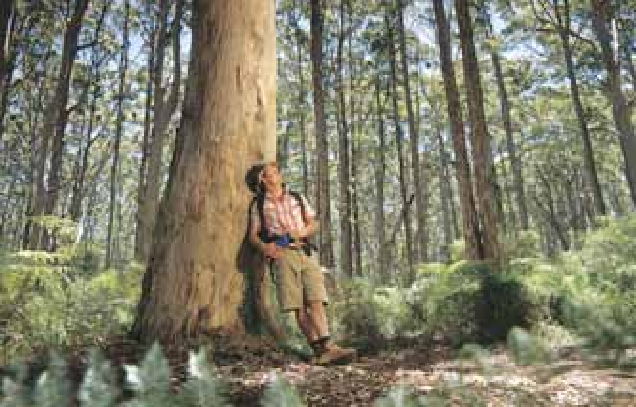The Great South West Edge
大西南边缘

Nature’s paintbrush has sculpted a landscape of extraordinary beauty hidden on the south western edge of this vast continent. Spectacular wildflowers create a breathtaking backdrop to some of the world’s whitest beaches, cleanest blue waters and most diverse marine ecosystems.
One of the world’s biodiversity hotspots, Australia’s Great South West Edge stretches 700 kilometres between Busselton and Esperance taking in breathtaking coastal scenery, ancient mountain ranges and vast swaths of natural bush. It is home to some of the rarest plants on earth — around 80 per cent of the plants found in this region can’t be found anywhere else in the world.
DIVERSITY ON A GRAND SCALE
The UNESCO Biosphere Reserve-listed Fitzgerald River National Park covers 329,000 hectares and is one of the most botanically significant parks in Australia containing more than 1,800 known plant species — more than all the plants found in the United Kingdom! The park is also home to 22 mammal, 41 reptile, 12 frog and over 200 bird species includingthe endangered ground parrot.
THERE’S NOTHING LIKE THE RADIANCE OF SOUTH WEST EDGE FLORA
Named after the Greek God Proteas, who was capable ofchanging his form at will, Australian members ofthe Proteaceae family range from small shrubs and striking bushes through to imposing trees, with colours of startling reds, pure apricots and mottled whites.
Afamily thoughtto have originated in South Africa when the earth’s southern lands formed the giant supercontinent of Pangea; the Proteaceae family has been in existence for over 140 million years. Ninety-six per cent of all Proteaceae species in the Great South West Edge are found nowhere else in the world.
FORESTS OFTHE SOUTH WEST EDGE
Some ofthe world’s tallest forests contemplate the sky in the Great South West Edge. Spectaculartuart trees grow up to 33 metres high with their trunks reaching 10 metres in circumference. These trees form part ofthe tuart forest - one ofthe rarest ecosystems on earth.
The beautiful rich red timbers ofthe 40 metre high jarrah trees around Nannup were once extensively harvested. Now protected, jarrah trees live for up to 500 years and the forest is home to more than 150 bird, 29 mammal, 45 reptile and 1,200 plant species.
With multi-coloured trunks of pink, orange, grey and white, majestictall karri forests grow between Manjimup and Denmark, while the unique red tingle tree boasts a trunk reaching up to 26 metres in circumference, hollowing over time to provide important wildlife habitat.
Climb Australia’s tallest trees
Experience life in the canopy — meet the challenge of climbing the spiral staircases of the 61 metre Gloucester Tree, the 75 metre Dave Evans Bicentennial Tree orthe 51 metre Diamond Tree. OrtaketheValley ofthe Giantstree top walkto see the world from 38 metres above the ground.
Walk the Bibbulmun track
The Bibbulmun Track stretches almost 1,000km and provides an opportunity to undertake a series of day walks or experience the full end-to-end adventure. The walk traverses a variety of jarrah, marri, wandoo, karri and tingle forests as well as internationally significant wetlands.
REMOTE ISLAND ARCHIPELAGO
Stretching for more than 230 kilometres, over 100 islands and 1,200 islets and rocky outcrops make up the spectacular Recherche Archipelago. On the larger islands you’ll see an array of wildlife including wallabies, bandicoots, snakes, frogs, sea eagles and Cape Barren geese.
One ofthe best diving spots in Australia, the sea floor is covered with extensive sea-grass meadows, spectacular reefs of soft corals and over 450 species of sponges — 150 of which have only recently been discovered. The Australian fur seal, penguins, dolphins, migratory whales, stingrays and Port Jackson sharks can all be found in these waters.
大西南边缘
在澳大利亚广袤大陆的西南边缘,大自然描绘了一幅绚丽的风景画。那里有着世界上最白透的沙滩,最清澈的蓝色海水,最丰富的海洋生态系统,争相盛开的绚烂野花成为了这些美景最动人的背景色。 澳大利亚的大西南边缘地区在布塞尔顿和埃斯佩兰斯之间绵延700公里,是生物多样性热门地点之一。这里有着令人惊叹的海岸风光、古老的山脉和大片的天然灌木,是地球上一些极稀有植物的家园——此处大约80%的植物在世界其他任何地方都无法寻觅。
丰富的生物多样性 菲茨杰拉德河国家公园属于联合国教科文组织生物圈保护区,占地32.9万公顷,是澳大利亚最具植物学研究意义的公园之一,包含1800多种已知植物物种,比英国所有的植物物种总量都多!公园里还有22种哺乳动物、41种爬行动物、12种蛙类和200多种鸟类,其中包括濒临灭绝的地鹦鹉。
无可比拟的西南边缘植物群风光 山龙眼科植物的英文名源于希腊神Proteas,这位神能够随意改变自己的形态,山龙眼科植物同样形态各异,从小灌木型到大灌木丛型,再到树型,种类繁多,色彩斑斓,有亮红色,纯杏色和斑驳的白色。
这种植物科据说来源于非洲,当时地球的南部陆地形成了巨大的泛大陆,而山龙眼科植物已经存在了1.4亿多年。在大西南边缘,96%的山龙眼科物种只生长于此。
西南边缘的森林群
大西南边缘有世界上最高大的森林,树干高耸入云。壮观的澳洲桉树高度可达33米,树干周长达10米。这些树木组成了桉树林,是地球上最稀有的生态系统之一。
南奴岛周围的红柳桉树树高可达40米,其美丽的木材曾经被过度开采。现在红柳桉树已经受到了保护,最高树龄可达500年。红柳桉树林为150多种鸟类、29种哺乳动物、45种爬行动物和1200多种植物提供了栖居之所。
郁郁葱葱的卡里木森林雄伟壮丽,仅在澳大利亚曼吉马普和丹麦生长,其树干色彩多样,有粉色、橙色、灰色和白色。独特的红色汀格树的树干周长可达26米,随着时间的推移,树干空鼓,为野生动物提供了重要的栖息地。 勇攀澳大利亚最高树 体验树冠中的生活——游客可以挑战沿着螺旋楼梯攀登61米高的格洛斯特树、两百年年岁的75米高的戴夫埃文斯古树或51米高的钻石树,亦或沿着巨人谷的树顶步道,在38米高的空中俯瞰地面风景。
比布蒙步道之旅
比布蒙步道延伸近1,000公里,为参与者提供了日间漫步和全方位体验探险之旅的机会。游客可徒步穿越红柳桉、美叶桉、鞣桉、卡里树和汀格树森林以及世界级的湿地区域。
遗世独立的群岛
100多座岛屿、1,200个小岛和岩石群组成了绵延230多公里的壮观的洛切切群岛。在较大的岛屿上,游客会观赏到多种野生动物,包括沙袋鼠、袋狸、蛇、蛙类、海雕和澳洲灰雁。 此地是澳大利亚最佳潜水点之一,海床上覆盖着广阔的海草,还有壮观的软珊瑚礁和450多种海绵动物——其中有150种最近才被发现。澳大利亚海豹、企鹅、海豚、洄游鲸、黄貂鱼和宽纹虎鲨在这片水域中生活得怡然自得。



